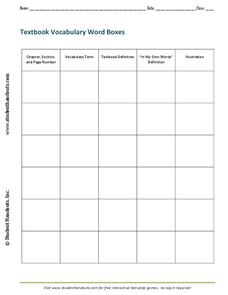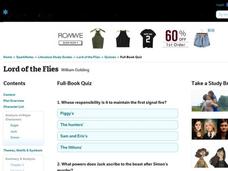It's About Time
Life (and Death) Before Seat Belts
Did you know only 80-90% of passengers wear a seat belt in a moving car? Young scholars use clay and a cart to complete an experiment about what happens without a seat belt in a collision. The lesson includes Newton's Second Law of...
It's About Time
Why Air Bags?
If a heavy steel car can't protect you from injury, how can a bag filled with air? The lesson answers this question and many others as young scientists experiment with the impulse and forces related to air bags in automobiles.
It's About Time
Automatic Triggering Devices
How does the air bag trigger in an accident? The lesson explores how automatic triggering devices work in automobiles. Using examples such as a seat belt lock and air bag, scholars design their own device to better understand the...
It's About Time
Cushioning Collisions (Computer Analysis)
Did you know the car bumper is specifically designed to save the car and not the passengers in case of an accident? Young scientists use a computer, a force probe, and a sonic ranger to experiment with external cushioning on cars.
It's About Time
Slinkies and Waves
Slinkies® are a great tool for visualizing waves. Pupils work in groups to create both transverse and longitudinal waves before using a polarizer to analyze the ways they are able to travel.
It's About Time
Inferences of Waves
Building on the previous lesson, scholars use Slinkies to create standing waves. They graph waves on a calculator and then apply their knowledge to both sound and light waves. This is the fourth in a series of nine lessons.
It's About Time
A Moving Frame of Reference
We often remind pupils to cite their references, but this lesson helps them understand there are many frames of reference. Scholars experiment with throwing a ball straight up in the air and catching it. Then they must do it again while...
It's About Time
Communication Through Space
If humans do find aliens, how would we communicate with them? An intriguing lesson walks through some of the challenges associated with this question. How long would a message take to reach a specific destination, what language should we...
EngageNY
Building Logarithmic Tables
Thank goodness we have calculators to compute logarithms. Pupils use calculators to create logarithmic tables to estimate values and use these tables to discover patterns (properties). The second half of the lesson has scholars use given...
Learning to Give
Why Volunteer?
Inspire scholars to volunteer their time to make a positive change in their community. With help from research, a public speaker, and reflection, learners define and asses what it takes to be a volunteer in a business, non-profit,...
British Council
William Shakespeare
After watching a three-minute video detailing the life of William Shakespeare, scholars take part in several activities designed to show what they know about the famous writer. Learners read a series of eight sentences and put them in...
Curated OER
Ask An Expert
Students explore various ways to use the Internet for extra help in school. In this technology lesson, students go to various "ask an expert" websites. Students review the process of using these Internet resources.
Curated OER
Sixth Grade is a Ball!
Students discuss the responsibilities of advancing in grade and participating in more activities. In this grade transition instructional activity, students watch a 'ball juggling' demonstration to visually identify the responsibilities...
Curated OER
My Pyramid
Tenth graders analyze the new Food Guide Pyramid. In this healthy diet lesson, 10th graders explore the the website with the new food pyramid. Students use magazines to find foods from the food groups and create their own pyramid....
Curated OER
Esperanza Rising
Sixth graders explore equality by reading a story with their classmates. In this discrimination lesson, 6th graders read the story Esperanza Rising and discuss the tensions between Latin America and the United States. Students view...
Curated OER
Graphs of Logarithmic and Exponential Functions
Students watch as the teacher demonstrates that y=ln(x) and y=e^x are inverse functions. They graph these equations on the same axes. Students work other log functions. They learn a Reggae Song about the log of the quotient. Students...
Curated OER
Family Letter and Activity: Cars, Trucks and Percents
In this math instructional activity, students will take home a letter to their parents explaining that they are studying Chapter 10: Ratio, Proportion and Percent. Then students will complete a homework activity in which they ask family...
Mind Snacks
Learn German - MindSnacks
Sprechen Sie Deutsch? Even if you can't speak German now, you'll be fairly accomplished after practicing with the games and words that make up the greater part of this app!
Student Handouts
Textbook Vocabulary Word Boxes
Encourage the development of proactive readers with this graphic organizer, which prompts pupils to identify words they do not recognize as they are reading a textbook or literary piece.
Curated OER
Lord of the Flies Quiz
How well does your class know the characters from William Golding's The Lord of the Flies? Learners respond to 25 multiple choice questions about the novel in an online interactive reading comprehension worksheet. They then submit their...
Curated OER
Reading Logs - Practice Creates Efficiency
Pupils examine how to identify the main idea and supporting details of a reading selection. They keep a reading log of what they read each day, reviewing their reading selections with the class.
Curated OER
Introduction to Inventions
Fourth graders construct an invention to the best of their creative ability using the teacher provided resources. They identify four scientific processes during the experiment and log them on the teacher prepared ditto.
Curated OER
No Title
Fourth graders, after brainstorming a list of things good friends do for each other, apply prereading strategies to the book, "Be A Friend to Trees," and create similes and metaphors utilizing content ideas. They also sketch an...
Curated OER
Complex Analysis: Rectangular Form
For this rectangular form worksheet, students write numbers in rectangular form. They solve complex numbers, and find the value of a function. This two-page worksheet contains approximately 12 multi-step problems.

























